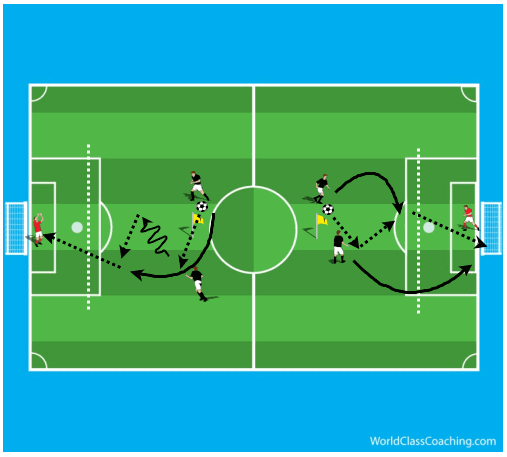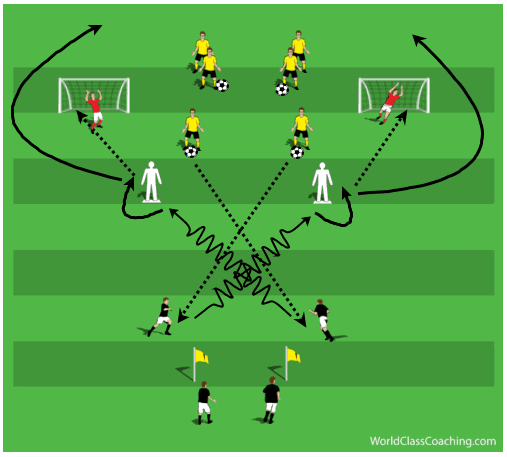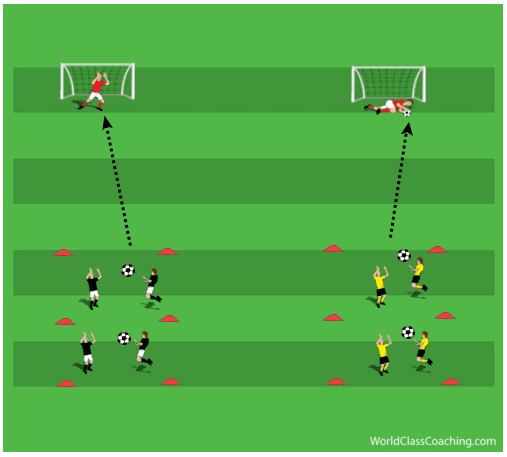By Chris Kouns
USSF A License (USSF Coaching Education Instructor) – NSCAA Premier Diploma (NSCAA Coaching Education Associate Staff Coach) – Head Coach Capital University Women’s Soccer (OH)
These finishing activities are designed to allow players to feel pressure (from competition and technical components) but not face defenders while working to improve their finishing.
Activity 1
Set up involves two different groups performing two different finishing activities, at the same time, for an allotted time period. Both teams will have pairs in the area designated by the starting flag and twill attack the goal they are facing with the following “combination options” There will be a live GK in each goal. Each group is responsible for keeping track of the goals their group scored during the time span.
OPTION A:
For two (2) minute time period one team will be performing a give-n-go (wall pass) while the other group will be performing an overlap. At the conclusion of the two (2) minute time frame the teams switch goals and then perform the other technical activity while finishing.
OPTION B:
For same two (2) minute time period both groups will be asked to perform their combination activity in one (1) touch fashion and must finish before the dotted line (16 yards from goal) At the conclusion of the two (2) minute time frame the teams switch goals and then perform the other technical activity while finishing.
OPTION C:
For same two (2) minute time period both groups will be asked to perform any other combinations that may be undertaken at the top of the box (in a game) to create a finishing opportunity. May also initiate a Seven (7) second “Clock” from the time the first pass is made to the time the ball hits the goal to increase pressure and replicate the necessity for quick finishing when the opportunity arises.
Coaching Points:
- Focus on playing the combination ball so that it can be finished on the first touch
- Make sure the angle of the touch and the ball played do not go wide of the frame of the goal to maximize finishing angles
- Take a peek before finishing so that you will be aware of the GK position and most available space to finish
- Look to finish to the back post first as this gives you the biggest target and opportunity for rebound finishing opportunities
- Player laying ball off in the combination MUST continue with the play and make a back post run for any rebound finishing opportunities
- When choosing combinations focus on those which players will find themselves most often using in and around the box in a game
Activity 2:
Two different groups will be facing each other for a three (3) minute finishing rotation. One group will begin by playing the balls to the group at the starting flags and then they will follow their ball to take their
Turn as the finishers. Those players finishing will run around the outside of the goal they are finishing on
and then join the lines playing the initial balls.
This activity can be set up using your preferred distance from goal, but, the closer the distance you will most likely need four goal keepers to rotate in the activity.
OPTION A:
For two (2) minute time period balls will be played simultaneously to two shooters waiting at the flags.
As soon as they receive the ball they must go on a full attacking spring towards the mannequin (crossing the path of the other attacker) where they will “beat the mannequin with a move and finish with a shot on goal.
OPTION A PROGRESSIONS:
A) Balls played to attackers on the ground
B) Balls played to attackers in the air
C) Balls played to attacker bouncing
D) Attackers have five seconds or less to get their shot off
E) Any ball that is not fielded in front of the attacker does not result in a finishing opportunity
Coaching Points:
- When attackers are receiving the ball make sure to get their body in line with the “flight” of the ball as quickly as possible so they can assure themselves maximum opportunity to keep the ball in front of them
- The first “Attacking Touch” should be a longer and more explosive touch to clear traffic. The shorter the touch or slower the start the more likely the attacker will run into the opposite attacker going across their path.
- When making their “move” on the mannequin the touch past them should be at an angle which will allow an immediate shot. Diagonal touches keep the ball in the path of the attacker… think “V” shape from the body
- Focus on releasing the shot as soon as you feel the ball has cleared the “reach” of the defender
- Entire attacking and finishing movement must be done “at speed” to ensure the opportunity will be taken in an appropriate time period for the game.
Activity 3:
Two different groups will be at the start of two “skill boxes” with each one measuring 6 x 6. Approximately 23 yards from the edge of the second skill box will be a full size goal and a live goalkeeper.
OPTION A:
Players will enter their “skill box” in pairs and must complete a designated technical task in order to move onto the second skill box or to move from the second skill box into the finishing opportunity. Each task must begin and end in the same box in order to move forward with the activity. If the ball touches the ground, leaves the grid or cannot be completed the pair in the box will vacate the box and a new pair will come in. Games are played until one team scores three (3) goals or can be adjusted for time to see how many finishing opportunities can we create in a three (3) minute time period.
PROGRESSIONS:
- In the first box this pattern must be completed (toss to start – head – head – volley – volley – catch). In the second box the patter will vary slightly * toss to start – head – head – volley – volley across the line towards goal where the partner not heading the ball must run onto the ball and finish it one time
- In the first box this pattern must be completed (toss to start – volley – head – volley – chest – catch). In the second box the patter will vary slightly * toss to start – volley – head – volley – chest/shoulder across the line towards goal where the partner not heading the ball must run onto the ball and finish it one time
- In the first box this pattern must be completed (toss to start – volley – volley – volley – volley – catch). In the second box the patter will vary slightly * toss to start – volley – volley – volley – volley across the line towards goal where the partner not heading the ball must run onto the ball and finish it one time
- In the first box this pattern must be completed (toss to start – chest/volley – chest/volley – chest/volley – catch). In the second box the patter will vary slightly * toss to start – chest/volley – chest/volley – chest/volley across the line towards goal where the partner not heading the ball must run onto the ball and finish it one time
Coaching Points:
- Players must be light on their feet and not “flat footed” so they can position themselves in order to “guide” the ball into the path of the next player touching the ball
- When playing the last touch make sure hips or shoulders are facing the area you want to lay the ball down for your partner to run onto and finish
- Focus on taking the air out of the last touch so the ball will not be bouncing when your partner tries to finish it
- Attackers should focus on adjusting their body in relation to the person laying the ball off. They want to make sure they are not ahead of them when they lay it down or they will struggle to get off a quality finishing opportunity
By Chris Kouns: USSF A License (USSF Coaching Education Instructor) – NSCAA Premier Diploma (NSCAA Coaching Education Associate Staff Coach) – Head Coach Georgia Gwinnet College Women’s Soccer (GA)





